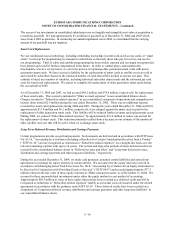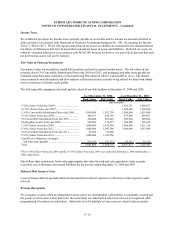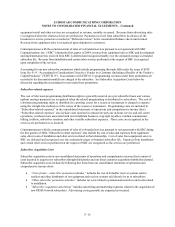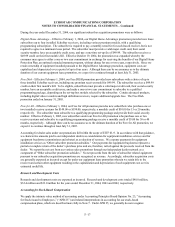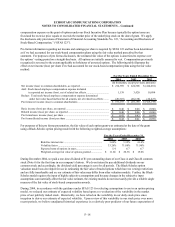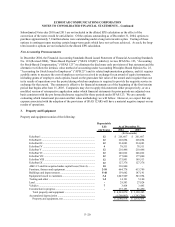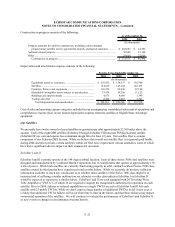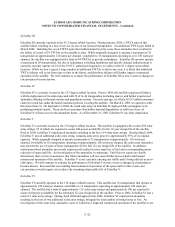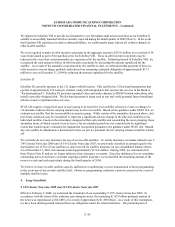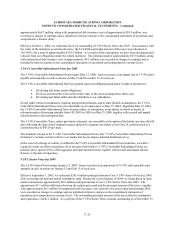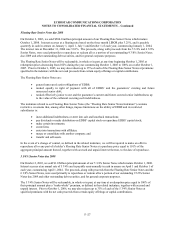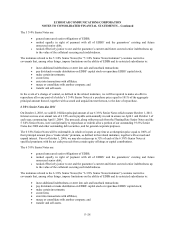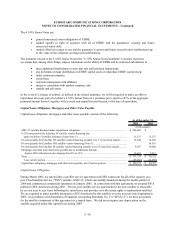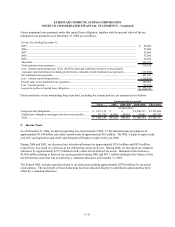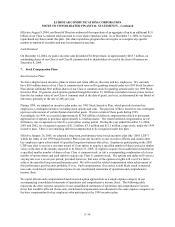Dish Network 2004 Annual Report Download - page 104
Download and view the complete annual report
Please find page 104 of the 2004 Dish Network annual report below. You can navigate through the pages in the report by either clicking on the pages listed below, or by using the keyword search tool below to find specific information within the annual report.ECHOSTAR COMMUNICATIONS CORPORATION
NOTES TO CONSOLIDATED FINANCIAL STATEMENTS – Continued
We depend on EchoStar VIII to provide local channels to over 40 markets until at least such time as our EchoStar X
satellite is successfully launched which is currently expected during the fourth quarter of 2005 (Note 9). In the event
that EchoStar VIII experienced a total or substantial failure, we could transfer many, but not all, of those channels to
other in-orbit satellites.
We were required to make in-orbit incentive payments in the aggregate amount of $15.0 million over a period of 14
years from launch as part of the purchase price for EchoStar VIII. These in-orbit incentive payments may be
reduced in the event that certain anomalies are experienced by the satellite. Following launch of EchoStar VIII, we
recognized the total amount of these in-orbit incentive payments by increasing the amount capitalized for the
satellite. As a result of the anomalies experienced by the satellite to date, we determined that payment of these in-
orbit incentives was no longer probable and reduced our remaining estimated obligation of approximately $13.7
million to zero as December 31, 2004 by reducing the amount capitalized for the satellite.
EchoStar IX
EchoStar IX currently operates at the 121 degree orbital location. This satellite has 32 Ku-band transponders that
operate at approximately 110 watts per channel, along with transponders that can provide services in Ka-Band (a
“Ka-band payload”). EchoStar IX provides expanded video and audio channels to DISH Network subscribers who
install a specially-designed dish. The Ka-band spectrum is being used to test and verify potential future broadband
initiatives and to implement those services.
SFAS 144 requires a long-lived asset or asset group to be tested for recoverability whenever events or changes in
circumstance indicate that its carrying amount may not be recoverable. Based on the guidance under SFAS 144, we
evaluate our satellite fleet for recoverability as an asset group. While certain of the anomalies discussed above, and
previously disclosed, may be considered to represent a significant adverse change in the physical condition of an
individual satellite, based on the redundancy designed within each satellite and considering the asset grouping, these
anomalies (none of which caused a loss of service for an extended period) are not considered to be significant
events that would require evaluation for impairment recognition pursuant to the guidance under SFAS 144. Should
any one satellite be abandoned or determined to have no service potential, the net carrying amount would be written
off.
We currently do not carry insurance for any of our in-orbit satellites. To satisfy insurance covenants related to our 9
3/8% Senior Notes due 2009 and 10 3/8% Senior Notes due 2007, we previously classified an amount equal to the
depreciated cost of five of our satellites as cash reserved for satellite insurance on our consolidated balance sheets.
As of December 31, 2003, this amount totaled approximately $176.8 million. During 2004, we redeemed all of
these Notes (Note 4) and are no longer subject to these insurance covenants. Since the indentures for our remaining
outstanding notes do not have covenants requiring satellite insurance, we reclassified the remaining amount of the
reserve to cash and cash equivalents during the fourth quarter of 2004.
We believe we have in-orbit satellite capacity sufficient to expeditiously recover transmission of most programming
in the event one of our in-orbit satellites fails. However, programming continuity cannot be assured in the event of
multiple satellite losses.
4. Long-Term Debt
9 3/8% Senior Notes due 2009 and 10 3/8% Senior Notes due 2007
Effective February 2, 2004, we redeemed the remainder of our outstanding 9 3/8% Senior Notes due 2009. In
accordance with the terms of the indenture governing the notes, the remaining $1.423 billion principal amount of
the notes was repurchased at 104.688%, for a total of approximately $1.490 billion. As a result of this redemption,
we have been discharged and released from our obligations under the related indenture. The premium paid of
F–24


